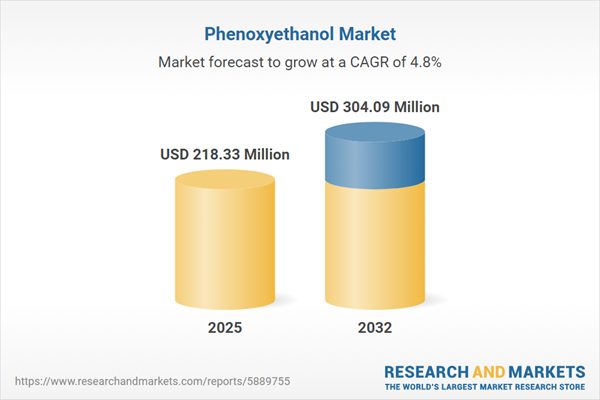Speak directly to the analyst to clarify any post sales queries you may have.
The phenoxyethanol market is undergoing notable change as global regulations tighten and organizations seek safer, more compliant ingredient solutions. Senior decision-makers must proactively manage shifting industry dynamics and embed resilience within procurement processes to safeguard operational continuity.
Market Snapshot: Phenoxyethanol Market Size, Growth, and Outlook
The phenoxyethanol market advanced from USD 208.32 million in 2024 to USD 218.33 million in 2025, reflecting a projected CAGR of 4.84% and an anticipated value of USD 304.09 million by 2032. Expansion is anchored by its critical applications in personal care, household cleaning, and pharmaceuticals, where it helps raise safety assurances and streamline regulatory compliance. Heightened global oversight is prompting companies to establish stronger compliance measures, while evolving regional frameworks and increased supply chain complexity require more robust sourcing approaches. Actionable intelligence forms the basis for sustainable growth and supports diverse product strategies that respond to both emerging risks and opportunities.
Scope & Segmentation: Market Structure and Core Segments
This comprehensive report provides segmentation frameworks designed for senior leaders to maximize procurement efficiency, drive risk management, and ensure compliance across the phenoxyethanol market. Segment-level analysis expands market visibility and strengthens decision-making for value creation.
- Applications: Spans household cleaning agents like dishwashing liquids, laundry detergents, surface cleaners; personal care products such as color cosmetics, hair care, skin care, and deodorants; and pharmaceuticals, including injectables and topical formats, helping leaders craft targeted procurement and formulation strategies.
- End Use Types: Covers both brand owners and contract manufacturing organizations within household, personal care, and pharmaceutical sectors, supporting the unique requirements of generic and branded operational models.
- Grade: Encompasses cosmetic, industrial, and pharmaceutical grades, aligned with specific industry certifications and performance benchmarks, providing buyers with clarity for quality assurance and compliance selection.
- Purity Levels: Includes premium, standard high, and ultra grades alongside low and medium groupings, ensuring regulatory alignment and customized market positioning for varied regulatory environments.
- Distribution Channels: Reflects direct sales arrangements, distributor-channels at local and national levels, as well as online purchasing through dedicated company platforms and third-party e-commerce, including scalable sourcing options.
- Regional Coverage: Details the Americas, Europe, Middle East & Africa, and Asia-Pacific, supporting leadership teams in navigating established, high-growth, and regionally complex markets with focused attention on compliance nuances.
- Companies Profiled: Features detailed benchmarking of major players such as Lonza Group AG, Ashland Global Holdings Inc., Symrise AG, BASF SE, Merck KGaA, Evonik Industries AG, Dow Inc., Clariant AG, Eastman Chemical Company, and LANXESS AG, informing procurement and competitive strategies.
Phenoxyethanol Market: Key Takeaways for Senior Leadership
- Regulatory scrutiny is rising, compelling organizations to adopt advanced frameworks for preservative safety, traceability, and environmentally responsible product design.
- Sustainable feedstock integration and green chemistry practices are reshaping both manufacturing and sourcing, prompting alignment with new environmental and compliance expectations.
- Digital analytics and quality management technologies are boosting supply chain transparency, assisting market participants in adapting to shifts and mitigating disruption.
- Increasing transparency in product formulations is driving differentiation for personal care and pharmaceutical brands, strengthening market trust and facilitating compliance.
- Strategic partnerships, capacity scaling, and network diversification remain crucial for business continuity, proactive risk mitigation, and longer-term sustainability across shifting market landscapes.
- Regional growth strategies provide entry to larger production capacities and access to premium market segments, particularly as industry regulations and local compliance requirements evolve.
Tariff Impact: Navigating US Trade Shifts
New US tariffs expected in 2025 are shaping procurement and operational approaches. To offset volatility, companies are widening their supplier networks, accelerating investments in domestic and nearshore production, and adjusting pricing structures. These measures not only enhance supplier relationships and build domestic capacity but also support teams in hedging against continued trade uncertainties and regulatory changes.
Methodology & Data Sources
This analysis is based on executive interviews and expertise from procurement leaders in household, personal care, and pharmaceutical industries, supported by regulatory filings, industry-wide analysis, and company financials. Both top-down and bottom-up methodologies are validated using advanced modeling of tariffs, global trade, and production capabilities.
Why This Report Matters
- Equips procurement and compliance teams to make informed decisions using detailed market segmentation and real-time regional insights.
- Builds resilience in sourcing strategies with a clear outline of regulatory and tariff implications, supporting supply chain strength and adaptability.
- Provides actionable benchmarking and sustainability guidance, enabling organizations to align practices with leading industry standards for best-practice adoption.
Conclusion
This report enables senior leadership to make well-informed decisions as the phenoxyethanol market evolves. Focused insights allow for proactive compliance, strategic innovation, and the reinforcement of resilient procurement frameworks in a changing regulatory landscape.
Additional Product Information:
- Purchase of this report includes 1 year online access with quarterly updates.
- This report can be updated on request. Please contact our Customer Experience team using the Ask a Question widget on our website.
Table of Contents
3. Executive Summary
4. Market Overview
7. Cumulative Impact of Artificial Intelligence 2025
List of Figures
Samples

LOADING...
Companies Mentioned
The key companies profiled in this Phenoxyethanol market report include:- Lonza Group AG
- Ashland Global Holdings Inc.
- Symrise AG
- BASF SE
- Merck KGaA
- Evonik Industries AG
- Dow Inc.
- Clariant AG
- Eastman Chemical Company
- LANXESS AG
Table Information
| Report Attribute | Details |
|---|---|
| No. of Pages | 196 |
| Published | October 2025 |
| Forecast Period | 2025 - 2032 |
| Estimated Market Value ( USD | $ 218.33 Million |
| Forecasted Market Value ( USD | $ 304.09 Million |
| Compound Annual Growth Rate | 4.8% |
| Regions Covered | Global |
| No. of Companies Mentioned | 11 |









